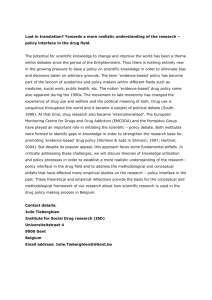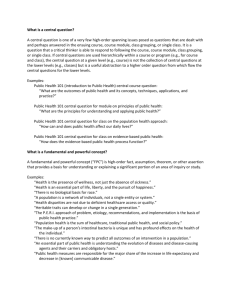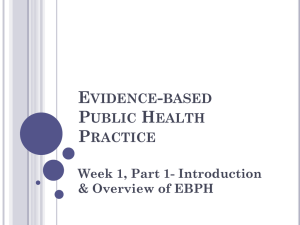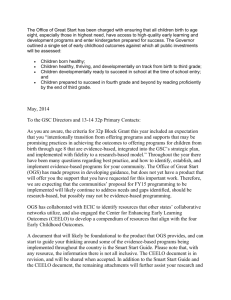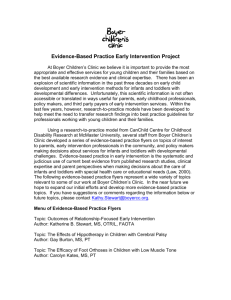EVIDENCE-BASED PRACTICE Evidence
advertisement
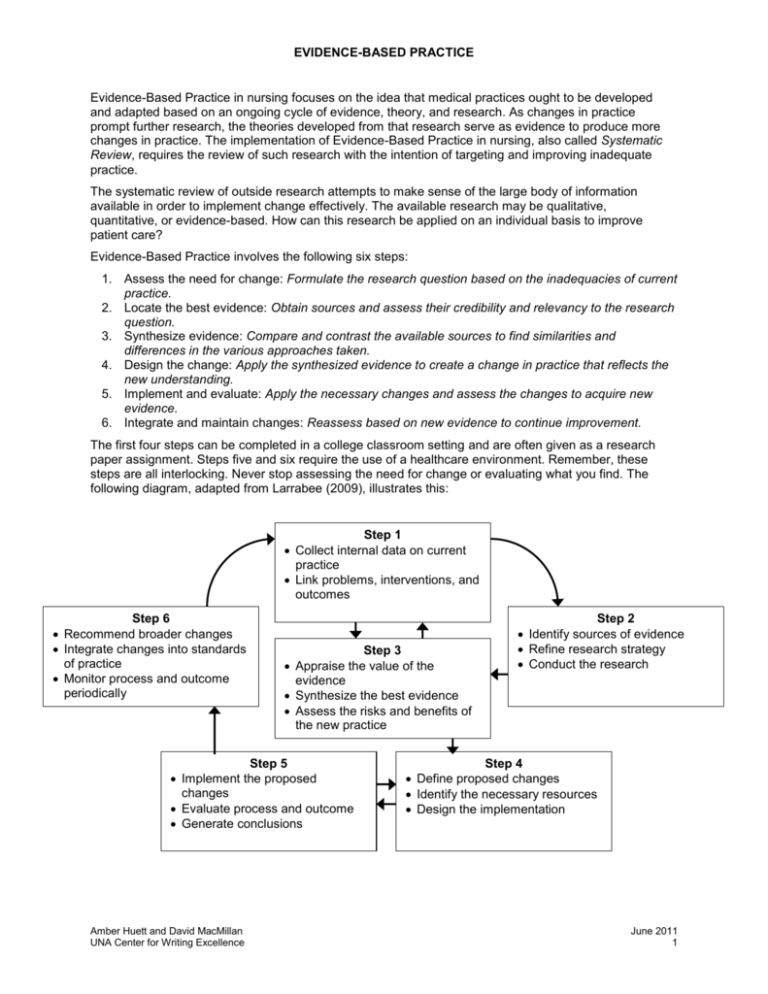
EVIDENCE-BASED PRACTICE Evidence-Based Practice in nursing focuses on the idea that medical practices ought to be developed and adapted based on an ongoing cycle of evidence, theory, and research. As changes in practice prompt further research, the theories developed from that research serve as evidence to produce more changes in practice. The implementation of Evidence-Based Practice in nursing, also called Systematic Review, requires the review of such research with the intention of targeting and improving inadequate practice. The systematic review of outside research attempts to make sense of the large body of information available in order to implement change effectively. The available research may be qualitative, quantitative, or evidence-based. How can this research be applied on an individual basis to improve patient care? Evidence-Based Practice involves the following six steps: 1. Assess the need for change: Formulate the research question based on the inadequacies of current practice. 2. Locate the best evidence: Obtain sources and assess their credibility and relevancy to the research question. 3. Synthesize evidence: Compare and contrast the available sources to find similarities and differences in the various approaches taken. 4. Design the change: Apply the synthesized evidence to create a change in practice that reflects the new understanding. 5. Implement and evaluate: Apply the necessary changes and assess the changes to acquire new evidence. 6. Integrate and maintain changes: Reassess based on new evidence to continue improvement. The first four steps can be completed in a college classroom setting and are often given as a research paper assignment. Steps five and six require the use of a healthcare environment. Remember, these steps are all interlocking. Never stop assessing the need for change or evaluating what you find. The following diagram, adapted from Larrabee (2009), illustrates this: Step 1 Collect internal data on current practice Link problems, interventions, and outcomes Step 6 Recommend broader changes Integrate changes into standards of practice Monitor process and outcome periodically Step 3 Appraise the value of the evidence Synthesize the best evidence Assess the risks and benefits of the new practice Step 5 Implement the proposed changes Evaluate process and outcome Generate conclusions Amber Huett and David MacMillan UNA Center for Writing Excellence Step 2 Identify sources of evidence Refine research strategy Conduct the research Step 4 Define proposed changes Identify the necessary resources Design the implementation June 2011 1 EVIDENCE-BASED PRACTICE The structure of an Evidence-Based Practice research paper requires four parts: Introduction, Methodology, Findings, and Discussion. Introduction Because Evidence-Based Practice focuses on specific elements, those elements need to appear in the introduction of your project description or research paper. The elements to include and organize can be planned based on the acronym PICO: Patient/Problem Intervention Comparison Outcome What problems does the patient group have? What needs to be solved? What intervention is being considered or evaluated? Cite appropriate literature. What other interventions are possible? Cite appropriate literature. What is the intended outcome of the research question? You should include a clear statement of the research problem at either the beginning or the ending of the introduction. This research problem can also be used to generate the research question used to the conduct the research itself. Methodology Instead of collecting data through surveys, interviews, or clinical records, as you would in a quantitative or qualitative study, the data you collect is the literature produced on your topic. Remember, the research you obtain is evidence just like quantitative or qualitative data. But what evidence do you select to analyze? Selecting evidence can be difficult, especially when you are considering making changes to common practices. You must assess the dependability of the source itself. Do not select sources simply because they work well with your topic. Using sources that are not credible will only serve to discredit your own ideas. Be prepared to discuss the following in a concise, scientific manner: 1. What databases did you search? What search terms did you use? How many total articles on the subject did you find? A search that returns few results may be the result of using search terms that are too narrow. Search terms need to use the specific vocabulary of the specific field of research. Try varying terms to match the genre of research you need. 2. What criteria led you to include or exclude sources? You may wish to present these criteria in the form of lists or tables. When evaluating sources, consider the following: Credibility: Is the study from a reputable researcher or journal? Databases can produce results from magazines or general reading material; these are not always peer-reviewed. Limit your search to scholarly journals. Validity: Does the study measure what it says it measures? What demographic sample did the study survey? The methods of examination and procedures of analysis make a big difference in the validity of results. Does the study present a margin of error? If so, is it narrow enough to make the results accurate? Reliability: Will the same test yield the same result? Did the study end as soon as favorable results were obtained? Were the reports consistent? A study should mention its own limitations; did the study have limitations that were not noted? You will want to use similar studies as much as possible. Because quantitative and qualitative studies measure different things, it will be difficult to integrate and synthesize the sources you acquire unless they are fairly similar. Your evidence-based practice review may use quantitative reviews, qualitative reviews, or other evidence-based practice reviews; comparing mixed methods will likely make your methodology more difficult to understand. If you are having trouble telling the difference between quantitative and qualitative studies, look at the Amber Huett and David MacMillan UNA Center for Writing Excellence June 2011 2 EVIDENCE-BASED PRACTICE methodology listed. Quantitative studies deal only with objective figures that can be measured, counted, and calculated. Qualitative studies will still use numbers to describe the sample and/or control groups, but they will focus on subjective analysis, descriptions, and interviews. In comparing the types of practice that your different studies seek to change or challenge, it is often useful to look at the reasons that certain practices are commonly held. Fawcett and Garity (2009) divide these reasons into “Four Methods of Knowing Used as Evidence” (10): Method Description Limitations Tenacity (or Tradition) “We’ve always done it that way; it’s the custom.” “The traditional way to do it here.” Authority “The textbook told me to do it this way.” “My teacher told me to do it that way.” May be prone to unforeseen error. Offers no way to decide which authoritative source is correct. A Priori “It seems reasonable.” May be subjective; one person’s idea of reasonable is not the same as another’s. Offers no way to determine whether ‘reasonable’ depends on the current way of thinking or on previous education. Theory “The theory guides me to do it.” Ignores contradictory evidence and opinions. No way to decide between conflicting opinions. May produce unanticipated negative outcomes. Must be developed through rigorous inquiry. May turn out to be false. Findings Your findings will be an analysis, possibly including a chart or table. You should present the studies you selected as the most appropriate sources for studying your problem and instituting your proposed change. Be sure to compare the following aspects of each study: 1. Demographics, pools, and samples 2. Methods of discovery and analysis 3. Results and limitations Remember that these studies are supposed to be the most reliable and valid studies available for answering the problem you found or the practice you wish to change. Your findings should lay the groundwork for you to make this argument in your discussion section. Discussion In a professional research environment, the discussion section should discuss the changed practice, its implementation, and its evaluation. However, this is impossible to do in a classroom situation. Therefore, do the following: 1. Argue that the findings lead to the specific change in practice you identified in your introduction. Amber Huett and David MacMillan UNA Center for Writing Excellence June 2011 3 EVIDENCE-BASED PRACTICE 2. Suggest a strategy for implementation. Will the change you recommend (and that these studies probably also recommend) work in your situation or not? Why? What changes might be needed? For further help in Evidence-Based Practice, read samples of published Evidence –Based Practice studies to get a good idea of how other healthcare professionals write these studies. Databases like CINAHL are good sources for these articles. Databases that allow you to limit your search to Systematic Reviews or Evidence-Based Practices will yield the best results. References Larrabee, J. H. (2009). Nurse to nurse: Evidence-based practice. New York: McGraw-Hill. Fawcett, J., & Garity, J. (2009). Evaluating research for evidence-based nursing practice. Philadelphia: F.A. Davis. Amber Huett and David MacMillan UNA Center for Writing Excellence June 2011 4
